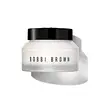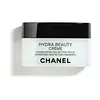What's inside
What's inside
 Key Ingredients
Key Ingredients

 Benefits
Benefits

 Concerns
Concerns

 Ingredients Side-by-side
Ingredients Side-by-side

Water
Skin ConditioningGlycerin
HumectantButyrospermum Parkii Butter
Skin ConditioningCaprylic/Capric/Myristic/Stearic Triglyceride
EmollientButylene Glycol
HumectantNeopentyl Glycol Diheptanoate
EmollientAlgae Extract
EmollientTocopheryl Acetate
AntioxidantSodium Hyaluronate
HumectantHelianthus Annuus Seedcake
AbrasiveGlycine Soja Seed Extract
Skin ConditioningCitrullus Lanatus Fruit Extract
Skin ConditioningSalvia Sclarea Extract
AntiseborrhoeicLens Esculenta Fruit Extract
Skin ConditioningPyrus Malus Fruit Extract
Skin ConditioningHordeum Vulgare Extract
EmollientCamellia Japonica Flower Extract
EmollientLactobacillus Ferment
Skin ConditioningPropylene Glycol Dicaprate
EmollientPolyacrylate Crosspolymer-6
Emulsion StabilisingSorbitol
HumectantSodium Polyaspartate
HumectantLecithin
EmollientTrehalose
HumectantCoco-Caprylate/Caprate
EmollientRosmarinus Officinalis Leaf Water
MaskingSodium Lactate
BufferingCucumis Sativus Fruit Extract
EmollientT-Butyl Alcohol
PerfumingSodium PCA
HumectantHydroxyethyl Urea
HumectantC9-12 Alkane
SolventSodium Acrylates Copolymer
Propanediol
SolventCitric Acid
BufferingDisodium EDTA
Potassium Sorbate
PreservativeSodium Benzoate
MaskingChlorphenesin
AntimicrobialPhenoxyethanol
PreservativeWater, Glycerin, Butyrospermum Parkii Butter, Caprylic/Capric/Myristic/Stearic Triglyceride, Butylene Glycol, Neopentyl Glycol Diheptanoate, Algae Extract, Tocopheryl Acetate, Sodium Hyaluronate, Helianthus Annuus Seedcake, Glycine Soja Seed Extract, Citrullus Lanatus Fruit Extract, Salvia Sclarea Extract, Lens Esculenta Fruit Extract, Pyrus Malus Fruit Extract, Hordeum Vulgare Extract, Camellia Japonica Flower Extract, Lactobacillus Ferment, Propylene Glycol Dicaprate, Polyacrylate Crosspolymer-6, Sorbitol, Sodium Polyaspartate, Lecithin, Trehalose, Coco-Caprylate/Caprate, Rosmarinus Officinalis Leaf Water, Sodium Lactate, Cucumis Sativus Fruit Extract, T-Butyl Alcohol, Sodium PCA, Hydroxyethyl Urea, C9-12 Alkane, Sodium Acrylates Copolymer, Propanediol, Citric Acid, Disodium EDTA, Potassium Sorbate, Sodium Benzoate, Chlorphenesin, Phenoxyethanol
Water
Skin ConditioningGlycerin
HumectantOctyldodecyl Neopentanoate
EmollientHydrogenated Polyisobutene
EmollientSilica
AbrasiveC12-15 Alkyl Benzoate
AntimicrobialPentylene Glycol
Skin ConditioningOctyldodecanol
EmollientPEG-40 Stearate
EmulsifyingCamellia Kissi Seed Oil
EmollientGlyceryl Stearate
EmollientAmmonium Acryloyldimethyltaurate/Vp Copolymer
Zingiber Officinale Root Extract
MaskingCamellia Japonica Flower Extract
EmollientButyrospermum Parkii Butter
Skin ConditioningPhytosteryl Canola Glycerides
Skin ConditioningPhenoxyethanol
PreservativeSaccharide Isomerate
HumectantCetyl Alcohol
EmollientSteareth-2
EmulsifyingDimethicone
EmollientParfum
MaskingCaprylyl Glycol
EmollientSodium Carbomer
Emulsion StabilisingLauroyl Lysine
Skin ConditioningPropylene Glycol
HumectantPEG-12
HumectantPentaerythrityl Tetra-Di-T-Butyl Hydroxyhydrocinnamate
AntioxidantSodium Hyaluronate
HumectantSodium Citrate
BufferingPhytic Acid
Citric Acid
BufferingTocopherol
AntioxidantAscorbyl Palmitate
AntioxidantSodium Benzoate
MaskingWater, Glycerin, Octyldodecyl Neopentanoate, Hydrogenated Polyisobutene, Silica, C12-15 Alkyl Benzoate, Pentylene Glycol, Octyldodecanol, PEG-40 Stearate, Camellia Kissi Seed Oil, Glyceryl Stearate, Ammonium Acryloyldimethyltaurate/Vp Copolymer, Zingiber Officinale Root Extract, Camellia Japonica Flower Extract, Butyrospermum Parkii Butter, Phytosteryl Canola Glycerides, Phenoxyethanol, Saccharide Isomerate, Cetyl Alcohol, Steareth-2, Dimethicone, Parfum, Caprylyl Glycol, Sodium Carbomer, Lauroyl Lysine, Propylene Glycol, PEG-12, Pentaerythrityl Tetra-Di-T-Butyl Hydroxyhydrocinnamate, Sodium Hyaluronate, Sodium Citrate, Phytic Acid, Citric Acid, Tocopherol, Ascorbyl Palmitate, Sodium Benzoate
Ingredients Explained
These ingredients are found in both products.
Ingredients higher up in an ingredient list are typically present in a larger amount.
This ingredient is also known as shea butter. It is an effective skin hydrator and emollient.
Emollients help soothe and soften your skin. It does this by creating a protective film on your skin. This barrier helps trap moisture and keeps your skin hydrated. Emollients may be effective at treating dry or itchy skin.
Shea butter is rich in antioxidants. Antioxidants help fight free-radicals, or molecules that may harm the body. It is also full of fatty acids including stearic acid and linoleic acid. These acids help replenish the skin and keep skin moisturized.
While Shea Butter has an SPF rating of about 3-4, it is not a sunscreen replacement.
Shea butter may not be fungal acne safe. We recommend speaking with a professional if you have any concerns.
Learn more about Butyrospermum Parkii ButterCamellia Japonica Flower Extract comes from the Japanese Camellia plant. This plant is native to East Asia and known as "Tsubaki" in Japanese.
Tsubaki flowers possess antioxidant and soothing properties. This flower has shown to be effective at fighting pollution damage by protecting your skin's fibroblasts. Your skin's fibroblasts help create collagen and collagen is responsible for youthful, plump skin.
This flower also contains many antioxidant enzymes. Antioxidants help fight free-radical molecules. Free-radical molecules are capable of damaging our cells and other genetic material. They may originate from sunlight, air pollution, or cigarette smoke. These free-radical molecules are unstable and are often looking for missing electrons. This instability causes free-radicals to damage our cells. Antioxidants help stabilize free-radicals by donating extra electrons.
Thus, Camellia Japonica Flower Extract may help reduce the signs of aging.
Learn more about Camellia Japonica Flower ExtractCitric Acid is an alpha hydroxy acid (AHA) naturally found in citrus fruits like oranges, lemons, and limes.
Like other AHAs, citric acid can exfoliate skin by breaking down the bonds that hold dead skin cells together. This helps reveal smoother and brighter skin underneath.
However, this exfoliating effect only happens at high concentrations (20%) which can be hard to find in cosmetic products.
Due to this, citric acid is usually included in small amounts as a pH adjuster. This helps keep products slightly more acidic and compatible with skin's natural pH.
In skincare formulas, citric acid can:
While it can provide some skin benefits, research shows lactic acid and glycolic acid are generally more effective and less irritating exfoliants.
Most citric acid used in skincare today is made by fermenting sugars (usually from molasses). This synthetic version is identical to the natural citrus form but easier to stabilize and use in formulations.
Read more about some other popular AHA's here:
Learn more about Citric AcidGlycerin is already naturally found in your skin. It helps moisturize and protect your skin.
A study from 2016 found glycerin to be more effective as a humectant than AHAs and hyaluronic acid.
As a humectant, it helps the skin stay hydrated by pulling moisture to your skin. The low molecular weight of glycerin allows it to pull moisture into the deeper layers of your skin.
Hydrated skin improves your skin barrier; Your skin barrier helps protect against irritants and bacteria.
Glycerin has also been found to have antimicrobial and antiviral properties. Due to these properties, glycerin is often used in wound and burn treatments.
In cosmetics, glycerin is usually derived from plants such as soybean or palm. However, it can also be sourced from animals, such as tallow or animal fat.
This ingredient is organic, colorless, odorless, and non-toxic.
Glycerin is the name for this ingredient in American English. British English uses Glycerol/Glycerine.
Learn more about GlycerinPhenoxyethanol is a preservative that has germicide, antimicrobial, and aromatic properties. Studies show that phenoxyethanol can prevent microbial growth. By itself, it has a scent that is similar to that of a rose.
It's often used in formulations along with Caprylyl Glycol to preserve the shelf life of products.
Sodium Benzoate is a preservative. It's used in both cosmetic and food products to inhibit the growth of mold and bacteria. It is typically produced synthetically.
Both the US FDA and EU Health Committee have approved the use of sodium benzoate. In the US, levels of 0.1% (of the total product) are allowed.
Sodium benzoate works as a preservative by inhibiting the growth of bacteria inside of cells. It prevents the cell from fermenting a type of sugar using an enzyme called phosphofructokinase.
It is the salt of benzoic acid. Foods containing sodium benzoate include soda, salad dressings, condiments, fruit juices, wines, and snack foods.
Studies for using ascorbic acid and sodium benzoate in cosmetics are lacking, especially in skincare routines with multiple steps.
We always recommend speaking with a professional, such as a dermatologist, if you have any concerns.
Learn more about Sodium BenzoateSodium Hyaluronate is hyaluronic acid's salt form. It is commonly derived from the sodium salt of hyaluronic acid.
Like hyaluronic acid, it is great at holding water and acts as a humectant. This makes it a great skin hydrating ingredient.
Sodium Hyaluronate is naturally occurring in our bodies and is mostly found in eye fluid and joints.
These are some other common types of Hyaluronic Acid:
Learn more about Sodium HyaluronateWater. It's the most common cosmetic ingredient of all. You'll usually see it at the top of ingredient lists, meaning that it makes up the largest part of the product.
So why is it so popular? Water most often acts as a solvent - this means that it helps dissolve other ingredients into the formulation.
You'll also recognize water as that liquid we all need to stay alive. If you see this, drink a glass of water. Stay hydrated!
Learn more about Water